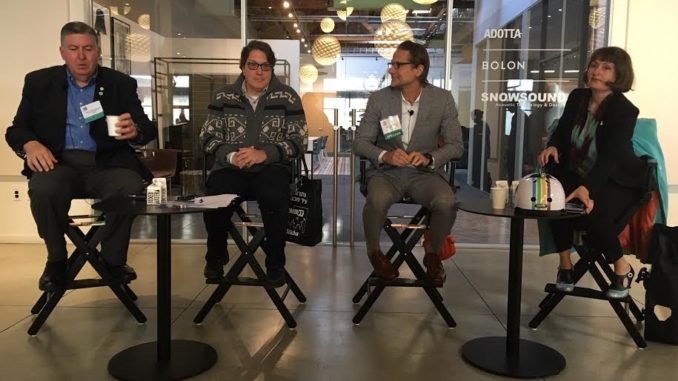
The Westside Urban Forum hosts panel discussions on urban planning issues, and one of their most popular panels is the annual Westside Mayors Forum. The room at the Helms Design Center was sold out, and the audience was there to hear Mayor John Mirisch of the City of Beverly Hills, Mayor Meghan Sahli-Wells of the City of Culver City, Mayor Kevin McKeown of the City of Santa Monica and Mayor John D’Amico, City of West Hollywood.
Moderated by Kerry Cavanaugh, a noted editorial writer from the Los Angeles Times, the urgent topic of housing was the start point for the conversation. While the other three mayors did not support SB 50, the housing bill that was just defeated for a third time in the Sacramento, Sahli-Wells defended it. “I don’t get to decide who wants to live here – and it’s great that so many people want to live here – but I can decide on how we can have equity for housing, and not just allow it all to be for the top 1%.”
McKeown agreed that the level of crisis was far beyond the ability of cities to solve one step at a time, but felt that SB50 was “another unfunded mandate. If they [the state of California] want to pay for this required housing, then it can and will happen. Leaving it up to the market is just creating more luxury housing.”
Transportation was another vital topic, and each city had it’s own challenges. D’Amico noted that the ratio of jobs to housing in West Hollywood was really quite balanced. “But those are numbers; only a very small percentage of the jobs in West Hollywood pay enough for people to afford to live in West Hollywood. so we have lots of people arriving and lots of people leaving, twice a day.”
Sahli-Wells noted that “We have developed our cities for the worst possible outcomes; the easiest thing to do is the worst for the planet, the worst for our health, the worst for our community…we need to be planning around people and not machines.”
Mirisch felt that long term stability had helped Beverly Hills to bypass many of these challenges. “In the past 60 years, we have had basically the same numbers of businesses, the same numbers of residents, with a slight uptick in the last few decades, but very slight- less than 5%. So we are not having the same growth issues as Culver City or Santa Monica.”
Water was another issue that looked at the history of the county and how many of the smaller cities had been able to remain independent because they have water resources. McKeown noted the long struggle that Santa Monica had with the oil companies who had polluted the water, and the legal victory that led to the clean-up. Santa Monica will, in the next few years, be able to rely on their own aquifer for most of their needs.
Sahli-Wells noted that the radical technological improvements made recently have made recycled water so much better, in both quality and cost, “it leaves [de-salination] far behind.”
The hour-long discussion felt much shorter, and the mayors each gave the impression that they had much more to say, but as always, the format was solid enough to feel satisfying.
The charms and character that reflect the small cities on the west side of Los Angeles was vividly shown to be as unique as the personalities that represented them.
Judith Martin-Straw
Photo caption – left to right, McKeown, Mirisch, D’Amico and Sahli-Wells.


Be the first to comment